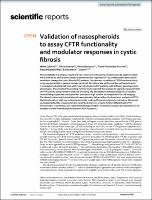Validation of nasospheroids to assay CFTR functionality and modulator responses in cystic fibrosis

Author
Date
2021-07-30Permanent link
https://hdl.handle.net/11351/7252DOI
10.1038/s41598-021-94798-x
ISSN
2045-2322
WOS
000683318500005
PMID
34330959
Abstract
The availability of a simple, robust and non-invasive in vitro airway model would be useful to study the functionality of the cystic fibrosis transmembrane regulator (CFTR) protein and to personalize modulator therapy for cystic fibrosis (CF) patients. Our aim was to validate a CFTR functional study using nasospheroids, a patient-derived nasal cell 3D-culture. We performed live-cell experiments in nasospheroids obtained from wild-type individuals and CF patients with different genotypes and phenotypes. We extended the existing method and expanded the analysis to upgrade measurements of CFTR activity using forskolin-induced shrinking. We also tested modulator drugs in CF samples. Immobilizing suspended-nasospheroids provided a high number of samples for live-cell imaging. The diversity observed in basal sizes of nasospheroids did not affect the functional analysis of CFTR. Statistical analysis with our method was simple, making this protocol easy to reproduce. Moreover, we implemented the measurement of inner fluid reservoir areas to further differentiate CFTR functionality. In summary, this rapid methodology is helpful to analyse response to modulators in CF samples to allow individualized treatment for CF patients.
Keywords
Cystic fibrosis; Predictive markers; Respiratory system modelsBibliographic citation
Calucho M, Gartner S, Barranco P, Fernández-Álvarez P, Pérez RG, Tizzano EF. Validation of nasospheroids to assay CFTR functionality and modulator responses in cystic fibrosis. Sci Rep. 2021 Jul 30;11:15511.
Audience
Professionals
This item appears in following collections
- HVH - Articles científics [4476]
- VHIR - Articles científics [1751]
The following license files are associated with this item:

 Private area
Private area Contact Us
Contact Us






